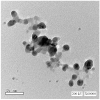Palliative Effect of Resveratrol against Nanosized Iron Oxide-Induced Oxidative Stress and Steroidogenesis-Related Genes Dysregulation in Testicular Tissue of Adult Male Rats
- PMID: 35805830
- PMCID: PMC9266693
- DOI: 10.3390/ijerph19138171
Palliative Effect of Resveratrol against Nanosized Iron Oxide-Induced Oxidative Stress and Steroidogenesis-Related Genes Dysregulation in Testicular Tissue of Adult Male Rats
Abstract
The nano-sized iron oxide (Fe2O3-NPs) is one of the most used engineered nanomaterials worldwide. This study investigated the efficacy of natural polyphenol resveratrol (RSV) (20 mg/kg b.wt, orally once daily) to alleviate the impaired sperm quality and testicular injury resulting from Fe2O3-NPs exposure (3.5 or 7 mg/kg b.wt, intraperitoneally once a week) for eight weeks. Spermiograms, sexual hormonal levels, oxidative stress indicators, and lipid peroxidation biomarker were assessed. Moreover, the steroidogenesis-related genes mRNA expressions were evaluated. The results showed that RSV substantially rescued Fe2O3-NPs-mediated sperm defects. Additionally, the Fe2O3-NPs-induced depressing effects on sperm motility and viability were markedly counteracted by RSV. Moreover, RSV significantly restored Fe2O3-NPs-induced depletion of testosterone, follicle-stimulated hormone, luteinizing hormone, and testicular antioxidant enzymes but reduced malondialdehyde content. Furthermore, the Fe2O3-NPs-induced downregulation of steroidogenesis-related genes (3 β-HSD, 17 β-HSD, and Nr5A1) was significantly counteracted in the testicular tissue of RSV-treated rats. These findings concluded that RSV could limit the Fe2O3-NPs-induced reduced sperm quality and testicular injury most likely via their antioxidant activity and steroidogenesis-related gene expression modulation.
Keywords: iron oxide nanoparticles; male sex hormones; oxidative stress; resveratrol; steroidogenesis-related genes.
Conflict of interest statement
The authors declare no conflict of interest.
Figures






References
-
- Pyrgiotakis G., Vedantam P., Cirenza C., McDevitt J., Eleftheriadou M., Leonard S.S., Demokritou P. Optimization of a nanotechnology based antimicrobial platform for food safety applications using Engineered Water Nanostructures (EWNS) Sci. Rep. 2016;6:21073. doi: 10.1038/srep21073. - DOI - PMC - PubMed
-
- ECHA European Union Observatory for Nanomaterial: Catalogue of Cosmetic Ingredients. 2019. [(accessed on 12 April 2022)]. Available online: https://euon.echa.europa.eu/catalogue-ofcosmetic-ingredients.
Publication types
MeSH terms
Substances
LinkOut - more resources
Full Text Sources

